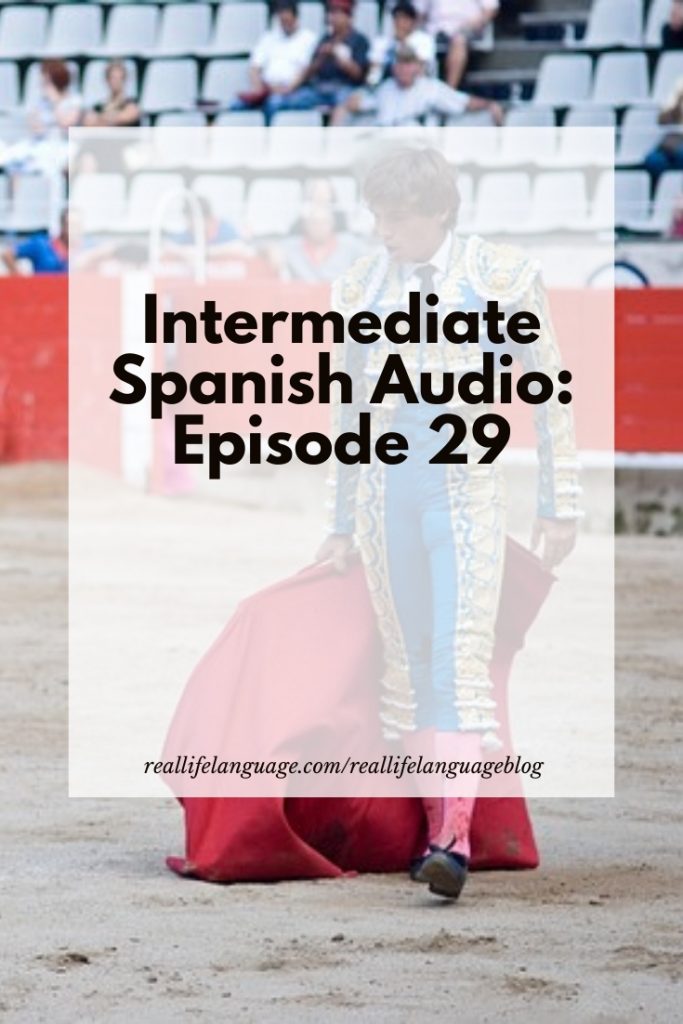Transcripts, Questions and Keys
Intermediate Spanish Audio: Episode 29
Welcome to Themes for Intermediate Learners of Spanish Speakers from Bolivia, Spain, and Argentina on Daily Life and Culture by Real Life Language.
Listen to real Spanish
Learn real Spanish.
Learn Spanish like a native from a native in this series of podcast episodes of conversations. Listen to intermediate Spanish audio about La corrida de Toros.
How to use this to learn Spanish:
- Listen to the episode. It is short, from a native speaker and at a normal speed.
- Read the questions.
- Listen to the episode, and work through the questions.
Estamos aquí en Las Ventas, la plaza de toros más importante del mundo. Desde el mes de mayo hasta el mes de septiembre las corridas de toros se ofrecen.
Tres matadores luchan contra tres toros. Cada matador lucha dos veces.
Turistas de todas partes del mundo vienen aquí para ver los espectáculos.
Aquí podemos ver espectadores sacando fotos de su visita a Madrid.
Esta estatua sirve para agradecer a todos los toreros que han luchado en Las Ventas.
La Comunidad de Madrid invierte mucho dinero en la plaza de toros y la formación de los matadores.
La cuadrilla entra. La cuadrilla es el equipo de toreros. El matador, los banderilleros y los picadores forman la cuadrilla.
El toro entra. El letrero tiene el peso del toro. Los toros pesan más de 400 kilos. Además de tener el peso en el letrero, tiene el nombre de la ganadería.
Durante el primer tercio, el matador observa el toro y hace una serie de pases (o movimientos) con el capote.
Los picadores salen a caballo, Los caballos llevan ropa protectora y los ojos están cubiertos con una venda. Los picadores pican el toro con varas para debilitar el toro. El toro trata de luchar el caballo. Los movimientos debilitan el toro aún más.
Los banderillos salen con banderillas. Pican el toro tres veces. Mientras tanto el matador sigue observando el toro pensando en estrategias que usará en el último tercio.
En el tercer tercio, el matador sale con una muleta y hace otra serie de pases. La espada se usa para matar el toro.
La estocada es cuando el matador pone la espada en el corazón del toro. El toro puede seguir luchando durante esta etapa.
El toro se cansa de luchar, se acuesta y muere.
Un carro sale con mulas para llevar al toro fuera de la plaza. Recortan el rabo y las orejas.
Dan una oreja al matador cuando fue una corrida buena.
I. Preguntas:
1. ¿Dónde está el escritor de la selección?
2. ¿Cómo se describe el lugar?
3. ¿Cuándo empieza la temporada de los toros?
4. ¿Cuándo termina la temporada de los toros?
5. En total, ¿cuántas luchas hay?
6. ¿De dónde vienen los turistas?
7. ¿Qué representa la estatua?
8. ¿Qué organización fomenta la formación de los matadores?
9. Describe la cuadrilla.
10. ¿Cuáles son tres detalles de cualquier toro que entra?
11. ¿Qué hacen los picadores?
12. ¿Qué hacen los banderilleros?
13. Describe la estocada. ¿Qué pasa al toro?
14. Describe los momentos finales de la corrida.
One of the things that we learn as we learn a language is about its culture. When we learn a language, we learn culture. This refers to the products, practices and perspectives of the people that speak the target language.
As a language teacher, I teach people how to bring their skills to the next level, and we do much of that through studying culture in the target language.
Bullfighting is not only an old tradition, it is also a controversial one. I wanted to share with you a couple of ways to use this context to learn Spanish to an advanced level.
- Read/listen to the episode.
- Answer the questions and dig deep into the vocabulary.
- Lee este artículo para una perspectiva de una región autónoma española:
https://elpais.com/espana/catalunya/2020-07-27/el-ultimo-tributo-a-los-toros-en-barcelona.html
Dig deep into the topic, repeating what you did with the first article. - Think about this question:
El tema de los toros tiene una tradición larga en los países hispanohablantes. Mucha gente dice que la tradición es cruel. Otros dicen que se debe ser protegida a causa de su historia en la cultura. ¿Crees que la tradición se debe ser prohibida? ¿Sí o no?
5. Organize your ideas in a graphic organizer in Spanish in bullet points.
5. Next, answer the question in a paragraph.
6. Use the ideas you noted in the graphic organizer to support your position. Go back to the sources and add details, elaboration and new vocabulary you learned in additional paragraphs.
7. Use this as an opportunity to learn some transitional phrases to connect your ideas. Here is a resource for some:
https://study.com/academy/lesson/spanish-transition-words.html
8. Write a conclusion restating your ideas.
Essentially, you should now have an essay or notes for a speech or debate. You will have created a product that clearly outlines your position on a topic with a well-developed argument. This is advanced-level language.
This exercise can be used with any topic about which you have strong opinions. This develops strong paragraph-level discourse, expands vocabulary and the skill of persuasion (all hallmarks of language level C/Advanced). These skills can carry over into other themes and bring you to an entirely new level of skill and fluency.
Need some help understanding? Check out this AMAZING resource. Readlang is one of the best tools out there to learn a new language by reading. This Google Chrome extension can help you break down and understand the text on the web. You can even upload a PDF. Understand, review and even make flashcards. There are free and paid versions. Check it out: https://readlang.com/
You can also use Readlang to find articles on topics in many languages to develop this advanced-level discourse.
Do you want the workbook? Get your free copy here: https://reallifelanguage.lpages.co/themes-for-intermediate-learners-of-spanish/
Do you want to master Spanish in the next year with intermediate Spanish audio? Check out the course here: https://real-life-language.teachable.com/p/the-5-week-linguist
Podcast: Play in new window | Download
Subscribe: RSS

